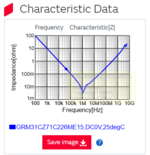kakiitek
Junior Member level 1
Hi all,
I am designing a simple step down dc voltage regulator. In the process of selecting output voltage capacitor, i observed that many ceramic capacitor have a self resonant frequency (SLF) of 1000kHz. Some questions below -
1. With the SLF of 1000kHz, we should design the regulator switching frequency well below the 1000kHz. Is that understanding correct?
2. Are there MLCC with SRF way above 1000kHz? So far package like 2016 and 1816 has more or less SRF of 1000kHz.
3. What happens when we choose a switching frequency that is equal to the SRF? Is that effectively a short for the ripple current since there is only the ESR?
4. I have seen schematics with voltage output cap that has the switching frequency very close to the capacitor SRF. The output is stable without any stability issues. Why is that so?
5. On another topic, i have also seen many output voltage capacitor which has an extreme low dc bias spec. Why does the regulation continue to work? For example, a MLCC of 6Vdc used as output capacitor of a Vout of 5.0V. Based on the datasheet, the capacitance is like 10% of its nominal value. Why does it continue to work?
Hope someone could help out here. Many thanks.
Kakiitek
I am designing a simple step down dc voltage regulator. In the process of selecting output voltage capacitor, i observed that many ceramic capacitor have a self resonant frequency (SLF) of 1000kHz. Some questions below -
1. With the SLF of 1000kHz, we should design the regulator switching frequency well below the 1000kHz. Is that understanding correct?
2. Are there MLCC with SRF way above 1000kHz? So far package like 2016 and 1816 has more or less SRF of 1000kHz.
3. What happens when we choose a switching frequency that is equal to the SRF? Is that effectively a short for the ripple current since there is only the ESR?
4. I have seen schematics with voltage output cap that has the switching frequency very close to the capacitor SRF. The output is stable without any stability issues. Why is that so?
5. On another topic, i have also seen many output voltage capacitor which has an extreme low dc bias spec. Why does the regulation continue to work? For example, a MLCC of 6Vdc used as output capacitor of a Vout of 5.0V. Based on the datasheet, the capacitance is like 10% of its nominal value. Why does it continue to work?
Hope someone could help out here. Many thanks.
Kakiitek
